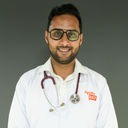How To Reduce Leg Fat?
Reducing leg fat requires a balanced approach that includes a proper diet, exercise, and lifestyle changes. Explore the effective strategies to reduce leg fat easily, along with the role of hydration and medical and surgical options.

Written by
Last updated on 3rd Jul, 2025
Reducing leg fat is a common fitness goal for many people. The amount of fat stored by one’s body could be influenced by genetics, lifestyle choices and metabolic factors. According to research, the healthy fat percentage of men ranges between 6-24%. Whereas for women, it lies between 14-31%. However, some individuals may accumulate more fat, especially in the lower body.
While it's not possible to lose fat from just one specific area, overall fat reduction is achievable. A healthy diet, regular exercise, and leg-focused workouts are key steps in achieving this goal.
This article discusses various nutritional tips, exercises, and medical procedures to reduce leg fat, making the process simpler.
Understanding Leg Fat
The extra fat that builds up in the thighs, calves, and hips, often due to genetics, diet, or lifestyle, is referred to as leg fat. It not only inhibits many physical activities but can affect the general well-being of the individual.
Leg fat includes different types of fat cells:
- Subcutaneous Fat: Fat that tends to collect directly beneath the skin is referred to as subcutaneous fat. It is the most common type of fat within the body. Most leg fat is subcutaneous fat, which generally has fewer health risks.
- Intramuscular Fat: This fat is found within the muscles.
Causes of Excess Leg Fat
There could be many causes for excess leg fat, including:
Genetic Factors
A person's genetic condition plays a key role in determining their likelihood of accumulating fat. This not only influences the overall amount of fat a person’s body carries but also plays a crucial role in deciding the specific areas of the body where this fat is stored.
Lifestyle and Diet
An unhealthy diet is usually the primary cause of increased levels of subcutaneous fat. People who have less muscle mass or do not exercise regularly tend to have a higher rate of fat gain.
Nutritional Strategies for Reducing Leg Fat
Usually, fat loss is aided by burning more calories than one eats. Here are some nutritional strategies that should be kept in mind for reducing leg fat:
Diet Plans that Target Leg Fat Reduction
The following should be kept in mind while constructing diet plans:
- Healthier foods, like fruits and vegetables, tend to have fewer calories.
- The National Institutes of Health (NIH) recommends eating a variety of fruits and vegetables, whole grains, and protein from various sources, like beans, nuts, seeds, lean meats, and eggs.
- Eating high-fibre foods can help with weight loss, as they take longer to digest, making one feel full longer.
- Many people choose low-carb diets for fat loss.
Foods to Avoid for Leg Fat Reduction
Reducing the intake of the following items is recommended:
- Carbohydrates
- Sugars
- Salt
- Red meat
Consult Top Dieticians
Exercise and Physical Activity for Reducing Leg Fat
Regular physical activity is essential for reducing excess leg fat and improving overall health. Here are some recommendations:
- Squats and Lunges: Doing squats and lunges activates the primary muscles in the legs, develops joint balance, and enhances endurance within the muscles.
- Aerobic Exercises: Cardio workouts raise the heart rate, boost metabolism, and help one lose leg fat.
- Leg Press and Resistance Training: Strength training exercises keep the muscles lean, which helps with fat loss.
- Jump Rope: This is a superb exercise that develops strength in the legs and improves circulation, aiding fat loss.
The Role of Hydration on Leg Fat Loss
Drinking water helps boost metabolism, control appetite, and support fat burning, making it essential for leg fat reduction:
- Water helps burn more calories and is also known to slightly boost the metabolism.
- When the stomach is full of water, it signals the brain to stop eating. This significantly helps in minimising appetite.
- Studies suggest that drinking water helps increase the rate of calories burned. Furthermore, drinking cold water might be beneficial because the body burns calories to heat it up for digestion.
Impact of Hormones on Leg Fat
Hormones regulate fat storage in the body. As a result:
- Changes in hormone levels can lead to weight gain or loss and affect where fat is stored.
- Fluctuations in thyroid hormones, insulin, cortisol, and other hormones can affect weight and fat distribution.
Some additional factors to consider are as follows:
- Lifestyle significantly influences the hormones related to body weight.
- Diets high in processed foods, added sugars, and refined carbohydrates can lead to hormonal issues.
- Sleep, activity, and stress levels also affect hormones.
Medical and Surgical Options for Leg Fat Reduction
For individuals struggling with stubborn leg fat despite a healthy lifestyle, medical and surgical treatments may provide a solution. Consulting a medical professional can help determine the most suitable approach based on health status and personal goals.
Surgical options for body contouring include:
- Lifts and Tucks: These surgeries remove excess fat and skin.
- Liposuction: This procedure, known as lipo, removes fat deposits through suction.
Non-invasive options available are:
- Laser therapy
- Cryolipolysis (fat freezing).
Lifestyle Changes to Promote Leg Fat Loss
Lifestyle changes play an important role in promoting leg fat loss. The following methods will make the process easier:
Incorporating Daily Physical Activity
Taking part in daily physical activities can be an effective way to reduce leg fat. In this regard, one should remember the following:
- Strength training builds leg strength and endurance using weights or resistance exercises.
- Cardio exercise raises heart rate.
- Adding a combination of both to the daily workout routine can help in better overall fat reduction.
Stress Management Techniques
Chronic stress raises cortisol levels, which can lead to fat storage. Here are some helpful stress management techniques:
- Mindfulness Meditation: This practice reduces stress and can help prevent emotional eating.
- Deep Breathing Exercises: Techniques like diaphragmatic breathing calm the nervous system.
- Regular Exercise: Activities such as walking, yoga, and strength training help reduce stress and promote leg fat loss.
- Adequate Sleep: 7-9 hours of sound sleep each night can help regulate hormones and control cravings.
Monitoring Progress and Setting Realistic Goals for Leg Fat Reduction
Tracking progress is essential for staying motivated and ensuring that the efforts lead to results. Several methods can be used to track body composition, such as:
- Skinfold Thickness Measurements: This method uses callipers to measure the thickness of a fold of skin, estimating body fat percentage.
- Bioelectrical Impedance Analysis (BIA): A small electrical current is used to estimate body fat percentage by measuring how tissues resist the flow of current in this procedure.
- Dual-Energy X-ray Absorptiometry (DXA): This method uses low-dose X-rays to measure bone density and body composition and is one of the most accurate methods available.
- Near Infrared Interactance: Near-infrared light is used to measure the thickness of fat under the skin to estimate body fat percentage.
Apart from this, it is crucial to set realistic goals that help in achieving leg fat loss in a healthy and sustainable way. Here are some strategies to consider:
- Goals should be Specific, Measurable, Attainable, Relevant, and Time-bound (SMART), providing a clear framework for progress.
- Documenting goals increases accountability and enhances the likelihood of success.
- Breaking larger goals into smaller, manageable steps facilitates steady progress.
- Setting realistic deadlines ensures effective time management while maintaining focus on objectives.
- Regularly reviewing progress ensures alignment with goals and allows for necessary modifications.
Conclusion
To reduce leg fat, it is essential to combine strength training with cardiovascular exercises. Activities such as squats, lunges, and jumping rope are effective for burning fat and building muscle. Additionally, maintaining a healthy diet that includes whole grains and lean proteins can support fat loss.
Drinking water boosts metabolism, controls appetite, and helps with digestion. Managing stress, getting better sleep, and considering medical treatments like laser therapy can also help reduce stubborn fat. Regular physical activity is vital for long-term results.
Consult Top General Physicians
Consult Top General Physicians

Dr Syed Mateen Pasha
General Physician
2 Years • MBBS
Bengaluru
PRESTIGE SHANTHINIKETAN - SOCIETY CLINIC, Bengaluru

Dr. Anand Ravi
General Physician
2 Years • MBBS
Bengaluru
PRESTIGE SHANTHINIKETAN - SOCIETY CLINIC, Bengaluru

Dr. Syed Ismail Ali
General Practitioner
7 Years • MBBS
Hyderabad
Apollo 24|7 Clinic, Hyderabad

Dr. Harshendra Jaiswal
General Physician/ Internal Medicine Specialist
12 Years • MBBS , MD (General medicine)
Kolkata
108 DHANA DHANVANTARI Clinic, Kolkata
(25+ Patients)
Dr. Thandra Ramoji Babu
General Physician/ Internal Medicine Specialist
5 Years • MBBS, DNB(General Medicine)
Warangal
Sai Ram multi-specialty hospital, Warangal
Consult Top Dieticians

Ms. Sushma Jaiswal
Dietician
42 Years • M.Sc.(Food & Nutrition)
Bengaluru
Swasthya Nutrition, Bengaluru

Neelanjana J
clinical nutrition
3 Years • Bsc., Msc. Nutrition and Dietetics.
Bengaluru
Apollo Clinic, JP nagar, Bengaluru

Ms. Soma Saha
clinical nutrition
17 Years • B.Sc. - Home Science (Food & Nutrition), M.Sc. - Home Science (Food & Nutrition)
Kolkata
Dr Utsa Basu Clinic, Kolkata
(50+ Patients)

Ms. Sreeparna Dey Dhara Deb
Dietician
10 Years • DNHE
Bansdroni
Siddhita Healthcare., Bansdroni

Ms. Priyanka Saini
Dietician
9 Years • Msc (Food & Nutrition),NDEP
Ghaziabad
Dr. PRIYANKA SAINI'S CLINIC, Ghaziabad
